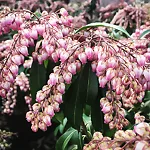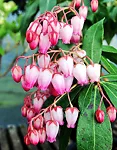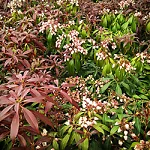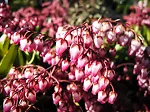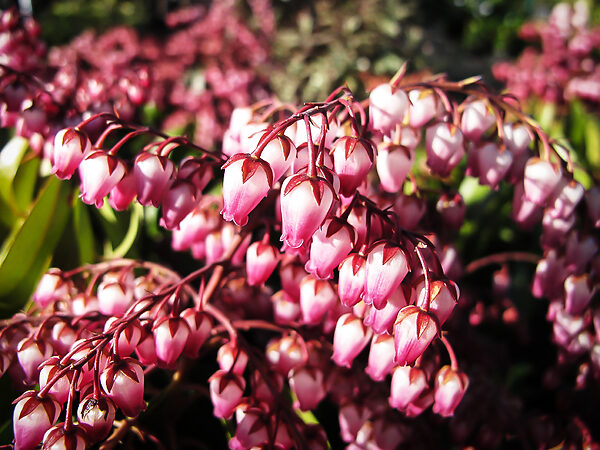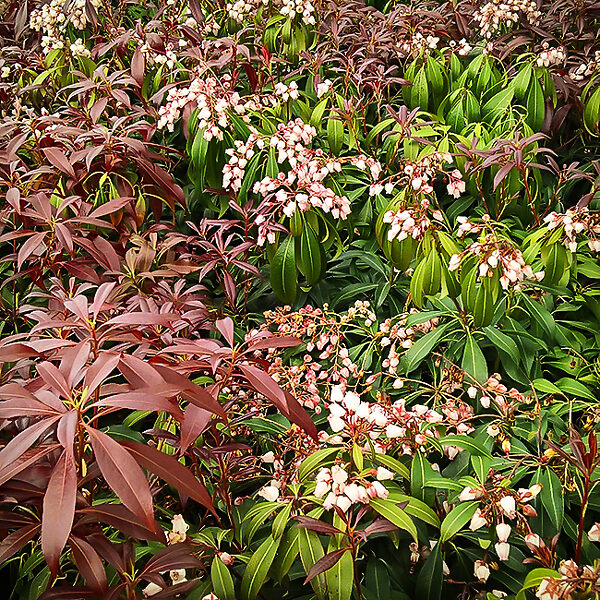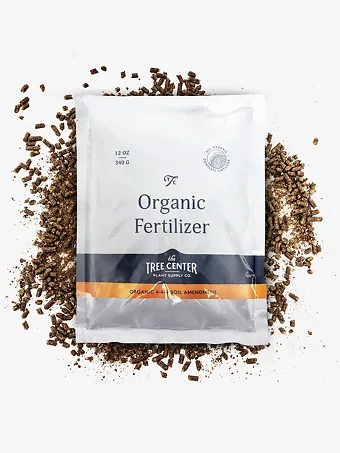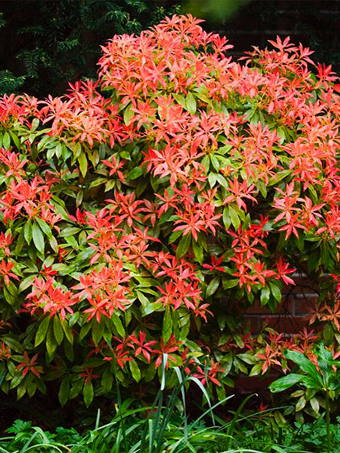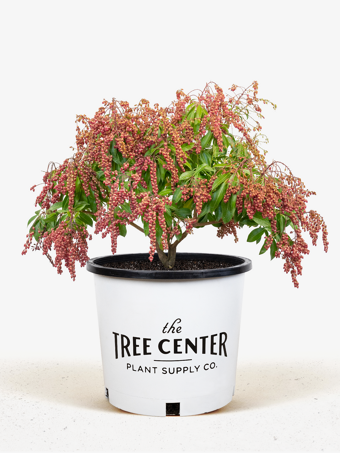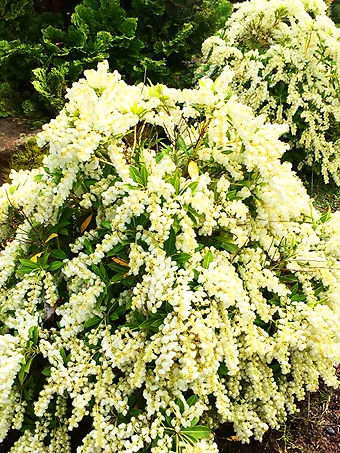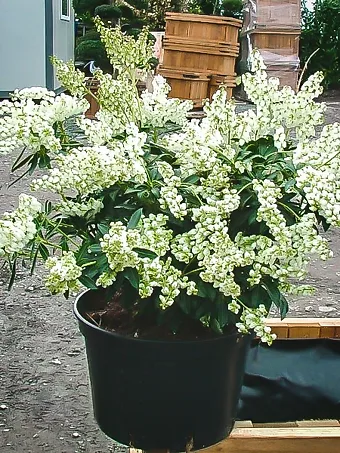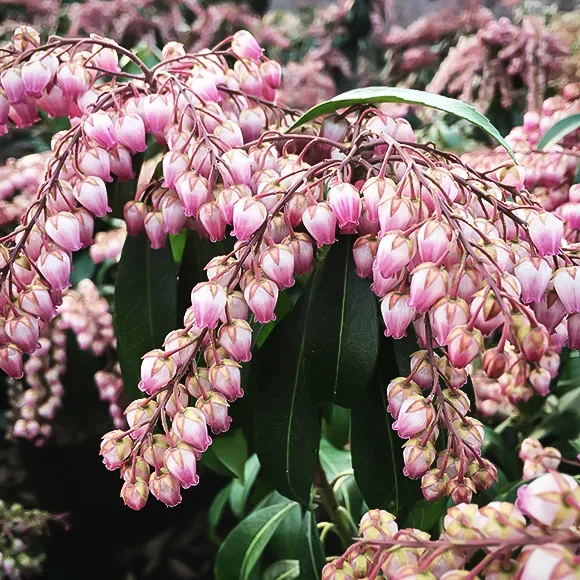
Katsura Pieris
Pieris japonica 'Katsura' (PP# 15,452)View more from Pieris
Katsura Pieris
Pieris japonica 'Katsura' (PP# 15,452)
Select Size
30 day - ARRIVE AND THRIVE™ guaranteeLearn more


Special Features

Botanical Name
Pieris japonica 'Katsura' (PP# 15,452)
Outdoor Growing zone
5-8
Mature Height
3-6
Mature Width
3-6
Sun needs
Partial Sun, Shade
The Katsura Pieris is a unique evergreen shrub for shady parts of your garden. It has vibrant, dark-red spring leaves, fading slowly through pink and pale green to the rich, dark green of the mature foliage. Before the leaves hanging clusters of pink flowers decorate every branch, a novel color for Pieris. It forms a rounded plant 3 feet tall and wide within 10 years, and it will eventually double that size. It is idea for shady beds around your home, out in the garden and in woodland settings.
- Wine-red spring growth makes a bold display
- Compact evergreen shrub for partial shade
- Spring flowers are pendulous pink sprays of bells
- Easier to grow than rhododendrons
- Ideal for planting beneath trees
Plant the Katsura Pieris in an area with morning sun and afternoon shade, or in light, broken shade all day. It grows best in rich, moist, well-drained acidic soil, but it is less demanding for that than rhododendrons are. If you don’t have suitable soil, grow it in a planter, using potting soil blended for acid-loving plants. It normally has no pests or diseases and it needs no trimming or pruning beyond removing the dead flower stems.
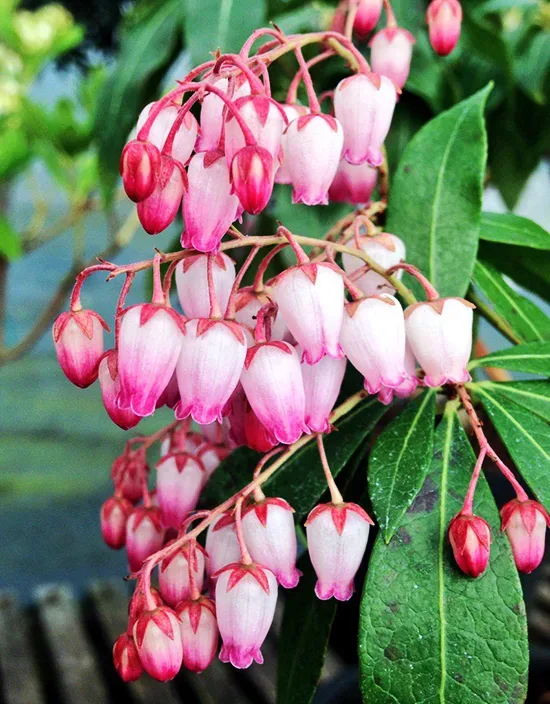
The Pieris, or Lily-of-the-valley bush, is a wonderful spring-blooming shrub that is known not only for its hanging bunches of bell-shaped flowers, but for the bright red spring shoots seen on some varieties. Most of the different forms that are available have white flowers – beautiful certainly, but some additional colors would be even better. That is exactly what makes the Katsura Pieris so desirable – the flowers are a lovely rosy-pink, not white. When they are still blooming and the wine-red new shoots appear as well, you truly have one of the highlights of spring in view. Perfect for shadier parts of your garden, the little extra care these plants need is more than repaid in the glory they bring to your garden every spring. Even when not blooming, the Katusura Pieris has noteworthy very dark evergreen leaves that draw admiration throughout the year.
Growing the Katsura Pieris
Size and Appearance
The Katsura Pieris is an evergreen shrub with a rounded form. It grows steadily, reaching 3 feet wide and tall within 10 years, and eventually it will be double that size. Don’t be misled by its small size when young and allow enough room for the final size of this magnificent plant. The leaves are small, about 2 inches long and ½ inch wide, but closely placed on the stems. With the many branches rising from the base the result is a dense, bushy plant. The leaves are leathery, smooth, and glossy, with minute serrations along the edges. In spring new leafy shoots come in clusters from the ends of the branches, and for several weeks these new leaves are a rich wine-red color, making a striking and dramatic display. They gradually fade to pink and then light green, before darkening to their full, mature, dark-green color. That rich tone is kept throughout summer, fall and winter.
In late September or October you will be able to make out the first signs of blooming. Tiny flower clusters, like minute fingers, form at the ends of the stems. These slowly expand over the winter and by early spring they are several inches long, hanging in dense clusters from the branch ends. The buds open to a beautiful rosy-pink color – something very different from other Pieris, which are normally white. The new leaf shoots often begin to grow before flowering is completely over, and the combination of colors is very beautiful. The hanging bell-shaped flowers look a lot like the blossoms of lily-of-the-valley, and they are fragrant.
Using the Katsura Pieris in Your Garden
With its love of partial shade, the Katsura Pieris is perfect for all those places in your garden that have some shade. These could be on the east side of your home, in the shadow or dappled shade of deciduous trees, or in open wooded areas. Grow it in beds with other acid-loving plants like camellia, rhododendron and azalea. In warmer zones it also makes a beautiful plant for containers and planters.
Hardiness
The Katsura Pieris is completely hardy in zone 6, 7 and 8. It will grow well in a sheltered spot in zone 5 as well, and in above-ground planters in zones 7 and 8. It grows best in climates that have cooler, damp summers and mild winters.
Sun Exposure and Soil Conditions
The perfect location for the Katsura Pieris would be where it had morning sun and shade from noon and through the afternoon. It will also enjoy light broken shade, such as we often see beneath well-spaced large deciduous trees. The ideal soil is moist, rich, well-drained and acidic, with a pH of less than 6.5, and preferably lower. Pieris is easier to grow in neutral or very slightly acidic soils than rhododendrons. Add plenty of acidic organic materials to the soil, and as mulch, and, if necessary, use of chelated iron. If you don’t have suitable soil, grow in a planter or pot, using potting soil blended for acid-loving plants, and azalea fertilizer.
Maintenance and Pruning
No pruning is needed – the Katsura Pieris naturally forms a neat, rounded bush. Remove the flower clusters when they finish blooming, without removing any foliage. Use lime-free mulch, like rotted leaves or pine needles, or peat moss, in spring to keep the soil cool and reduce water loss. Water during dry periods, as this plant is not drought resistant. Insects and pests are normally not a problem, and with the right light, soil, and moisture, this plant is relatively easy to grow well.
History and Origin of the Katsura Pieris
The Japanese andromeda, or lily-of-the-valley bush, Pieris japonica, grows wild in forests in Japan, Taiwan and some parts of China. Since it was first grown in gardens improved versions have been selected by nurseries and plant enthusiasts. Dr. Yoshimichi Hirose is a plant collector and writer who lives in Yamate-Chou, outside Yokohama. In 1986 he found a unique branch on a plant of Japanese Pieris. It was unique because of its pink flowers and the very dark red of its young shoots. He grew this piece into a plant and named it ‘Katsura’. There is a Shinto shrine called that in Japan, but it seems more likely that it was named after Yoshimichi’s wife. It was first introduced in Europe by PlantenTuin Esveld, a nursery in Boskoop, the Netherlands, and protected by European Plant Breeder’s Rights. Later, in 2004, it was granted a US Plant Patent and became available in the USA.
Buying the Katsura Pieris at The Tree Center
The unique rich coloring of the spring growth makes the Katsura Pieris a very showy plant. Combine that with the unusual pink flowers and you have something truly special. These rare Pieris varieties are always in short supply, so our very limited stock will soon be gone. Order yours right away.
